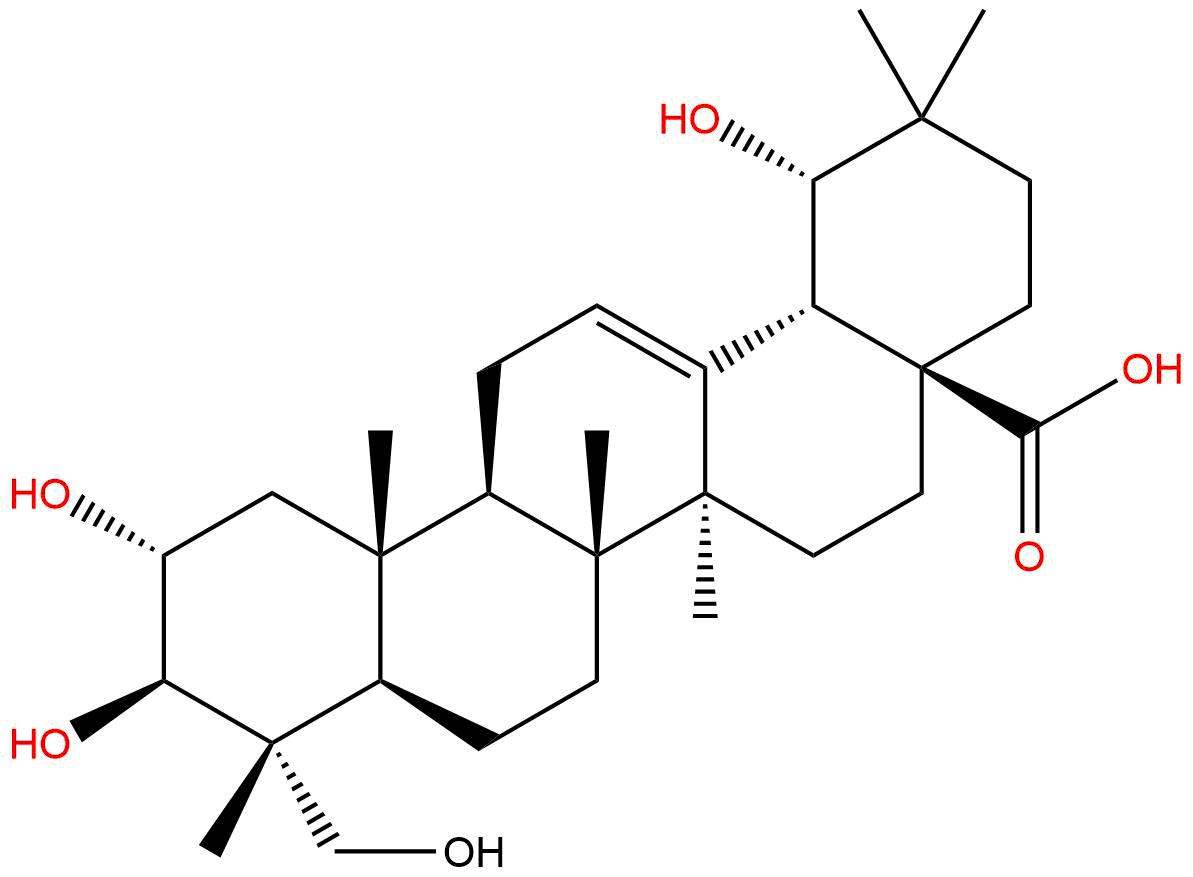
ArjungeninCAS No.:58880-25-4
|
||||||||||
 |
|
|
||||||||

| Catalogue No.: | BP2029 |
| Formula: | C30H48O6 |
| Mol Weight: | 504.708 |
Product name: Arjungenin
Synonym name: 2-alpha,19-alpha,23-Trihydroxyoleanolic acid
Catalogue No.: BP2029
Cas No.: 58880-25-4
Formula: C30H48O6
Mol Weight: 504.708
Botanical Source:
Physical Description:
Type of Compound: Triterpenoids
Purity: 95%~99%
Analysis Method: HPLC-DAD or/and HPLC-ELSD
Identification Method: Mass, NMR
Packing: Brown vial or HDPE plastic bottle
Storage: Store in a well closed container, protected from air and light. Put into refrigerate or freeze for long term storage.
The product could be supplied from milligrams to grams
Inquire for bulk scale.
For Reference Standard and R&D, Not for Human Use Directly.
Description:
Arjungenin shows β-glucuronidase inhibitory activity, it shows antiviral, and anti-inflammatory activities. Arjungenin exhibits moderate antibacterial activity against Staphylococcus aureus, Escherichia coli and Enterococcus faecalis (MICs within a range of 64 and 256 ug/mL). Arjungenin shows significant protection against domoic acid induced toxicity in Caco-2 cell line.
References:
Cytotechnology. 2017 Aug;69(4):725-739.
Modulatory effects of Terminalia arjuna against domoic acid induced toxicity in Caco-2 cell line.
Domoic acid is a potent marine algal toxin produced by diatomic genus of Pseudo-nitzschia causing amnesic shell fish poisoning. Domoic acid toxicosis mainly involves excitotoxic effects coupled with oxidative stress.
METHODS AND RESULTS:
The present study was aimed to evaluate the protective effects of hydro-alcoholic extract of Terminalia arjuna (TA) against domoic acid induced toxic effects in Caco-2 cell line. It was observed that the toxicity induced by domoic acid in Caco-2 cells was mediated by oxidative insult leading to morphological changes, DNA damage and apoptosis. In our study pre-treatment of the cells with TA (10, 20 and 30 μg/ml) showed significant protection against domoic acid induced morphological, oxidative and apoptotic damages in a dose dependent manner. The effect of phytocompounds present in TA viz., kaempferol and Arjungenin showed significant protection against domoic acid induced toxicity in Caco-2 cell line.
CONCLUSIONS:
Hence, it could be inferred that the protective effect of TA extract against domoic acid induced toxicity could be due to the individual or synergistic effects of kaempferol and argungenin. However, further clinical studies are warranted to consider TA as a natural remedy to prevent amnesic shell fish poisoning.
Fitoterapia. 2016 Apr;110:89-95.
Antibacterial and cytotoxic triterpenoids from the roots of Combretum racemosum.
A new pentacyclic triterpenoid glucoside, together with fourteen known compounds, was isolated from the roots of Combretum racemosum. Combretaceae).
METHODS AND RESULTS:
The structure of the new compound was established as 28-O-β-d-glucopyranosyl-2α,3β,21β,23-tetrahydroxyolean-18-en-28-oate (1) on the basis of detailed spectroscopic data including MS, 1D, and 2D NMR. The inhibitory activity of compounds 1-15 against promyelocytic leukemia HL-60 and human erythromyeloblastoid leukemia K562 cell lines was evaluated. Compounds 11 (3-O-β-acetyl-ursolic acid), 14 (betulinic acid), and 15 (quadranoside II) exhibited significant cytotoxicity, with IC50 values of 13 to 50 μM. Among the isolated triterpenes, compounds 1, 3 (Arjungenin), 5 (terminolic acid), and 11 exhibited moderate antibacterial activity against Staphylococcus aureus, Escherichia coli and Enterococcus faecalis (MICs within a range of 64 and 256 μg/mL).
Zeitschrift Für Naturforschung B, 2005, 60(3):347-350.
Some chemical constituents of Terminalia glaucescens and their enzymes inhibition activity.
METHODS AND RESULTS:
A new triterpenoid, glaucinoic acid (2α, 3β, 19α, 24-tetrahydroxyolean-12-en-30-oic acid) (1) along with several known compounds, arjunic acid (2), Arjungenin (3), sericoside (4), and friedelin (5) were isolated from the stem barks of Terminalia glaucescens.
CONCLUSIONS:
These compounds showed β-glucuronidase inhibitory activity. The structures were identified on the basis of spectroscopic techniques.
HPLC of Arjungenin

HNMR of Arjungenin
